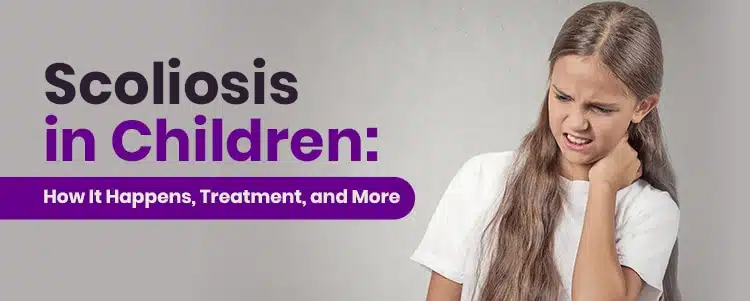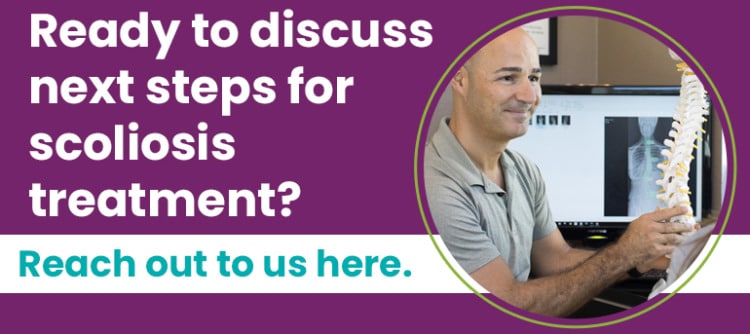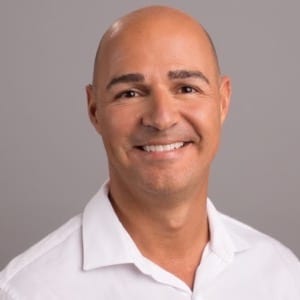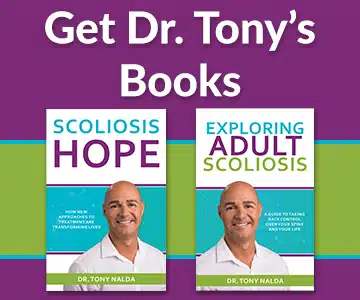When scoliosis develops in children before reaching adolescence, this is called ‘pediatric scoliosis’, and scoliosis diagnosed in adolescents between the ages of 10 and 18, with no known cause, is known as ‘adolescent idiopathic scoliosis’ (AIS). While adolescents, technically, are still in the pediatric phase of development, the way their bodies respond to the condition is very different from how it affects younger children; keep reading to find out how and why.
When it comes to understanding scoliosis in children, it’s especially important for parents and caregivers to know the signs to look out for, as well as the different forms that fit under the umbrella of pediatric scoliosis: infantile and early-onset juvenile. Adolescent scoliosis, especially adolescent idiopathic scoliosis (AIS) affects older children and is the condition’s most common form.
Before we move on to talking about the individual condition forms, I’d like to first explore the general topic of scoliosis progression, in the hopes of providing some clarity to an issue that many young patients and parents find unclear.
What is Scoliosis?
Scoliosis is a medical condition characterized by an abnormal curvature of the spine, often resembling an “S” or “C” shape. While it can affect individuals of any age, it is most commonly diagnosed in children and adolescents. The causes of scoliosis can vary widely, including genetic factors, muscle imbalances, and spinal injuries. In many cases, however, the cause remains unknown, and this is referred to as idiopathic scoliosis. Understanding the nature of scoliosis is the first step in recognizing and addressing this condition effectively.
Understanding Scoliosis Progression
As a progressive condition, scoliosis is going to get worse over time, if left untreated, because it is in its nature to do so; this means that the abnormal sideways spinal curvature, with rotation, will get larger.
Scoliosis is classified as mild, moderate, or severe based on the size of the curvature. As a curvature gets larger, it can produce more noticeable symptoms such as postural changes.
Here at the Scoliosis Reduction Center®, our goal is to be proactive in our treatment so our patients never have to deal with the hardships that come with reaching those higher stages of progression.
For young people and their parents and/or caregivers, the topic of scoliosis progression can seem very daunting, mysterious, and unclear. Understanding progression is important because treating scoliosis means effectively managing its progressive nature and trying to stay ahead of the condition’s progressive line. As a child grows, growth spurts can significantly affect the progression of spinal curves, making timely interventions like bracing and monitoring crucial to prevent worsening of the condition.
To help people better understand this crucial aspect of scoliosis, I’ve put together some general progression-related topics that I think will help shed some light on the subject: age, skeletal maturity, gender, and curvature pattern.
Age
As mentioned, progression is the big challenge we are facing with scoliosis treatment. As the condition is incurable, we have to do what we can to stay ahead of its progression; with some forms, that is easier than in others, but it is always a factor.
For children diagnosed with scoliosis at a younger age, most often, they are at a higher risk of curvature progression. This is because the biggest trigger for progression is growth and development. A child’s age is crucial in determining the appropriate interventions and treatment plans, as factors such as age and skeletal maturity are critical when evaluating a child’s specific needs and potential progression of their condition.
The younger a patient is, the more growth and development they have yet to go through, which means there is a high likelihood that their curvature will increase as they grow and develop.
For children under the age of 10, a small curvature between 5 and 19 degrees has a 45-percent chance of getting bigger, but a curvature that measures between 20 and 29 degrees has an almost 100-percent of progressing.
Basically, as children get older, these percentages will likely decrease, but of course the operative word here is ‘likely’ because there is no hard-and-fast rule to accurately predict any patient’s rate of progression.
Skeletal Maturity
When a patient has reached skeletal maturity, this means they are no longer growing, and this is so significant for scoliosis because it means the big trigger for progression has been removed.
Now, to know approximately how much progression a child is facing would be akin to knowing exactly how much growth they have yet to go through. This is crucial for understanding the development of the child’s spine.
Fortunately, there is a growth indicator that can help us predict this: the Risser sign.
The Risser Sign
A patient’s Risser sign is visible on their scoliosis X-ray images and looks to pelvic calcification levels to measure skeletal maturity.
This measurement tells us how much more a child has to grow, and in doing so, helps us predict their rate of progression in the child’s spine.
Measured on a scale of zero to five, five being skeletal maturity reached in adulthood, the higher the Risser score, in most cases, the less likely a curvature is to progress.
Gender
When most people think of scoliosis, the image of a 16-year-old girl comes to mind; this is because girls are at a higher risk of progression than boys.
While the reason behind this is not fully understood, it’s thought that the higher prevalence of scoliosis progression in girls is due to the fact that girls mature faster than boys. They hit puberty earlier, meaning they have more growth and development to go through starting at an earlier age, and hormones could also play a role.
In fact, for curvatures larger than 30 degrees, girls are ten times more likely to go through scoliosis progression.
So gender can be another factor that helps us predict a young patient’s likeliest rate of progression.
Curvature Pattern
In addition to age and gender, another factor that can help us predict progression is the pattern of the abnormal spinal curvature; some curvature patterns are more prone to progression than others.
There are three main sections to the human spine: cervical (upper back and neck), thoracic (middle back), and lumbar (lower back). While scoliosis can develop anywhere along the spine, thoracic curves, which also happen to be more common, are also more prone to progression.
Now that we’ve discussed some of the general characteristics that affect progression in children and adolescents, let’s turn our focus to facts about pediatric scoliosis and treatment that are important to understand.
Identifying Scoliosis
Identifying scoliosis in children can be particularly challenging, as the condition often does not cause noticeable symptoms in its early stages. However, there are several signs that parents and caregivers can watch for. These include uneven shoulders, hips, or waistlines, and a visible curvature of the spine when the child bends forward.
If you suspect that your child may have scoliosis, it is crucial to consult with a healthcare provider for a proper diagnosis and to develop an appropriate treatment plan. Early detection can make a significant difference in managing the condition and preventing further complications.
Important Pediatric-Scoliosis Facts
In addition to gaining a better understanding of triggers for and patterns of progression, the following pediatric-scoliosis facts are important to address because they give a better understanding of treatment options and consequences.
Presently, we will touch on how healthcare providers diagnose scoliosis in children through various physical examinations and screening tests, such as the Adams Forward Bend Test. Early diagnosis is crucial as scoliosis can often be asymptomatic and may be overlooked until rapid growth during puberty. We will also discuss surgery, lifestyle, and the two main treatment approaches.
The Benefits of Early Detection
While it’s always better to know what’s going on in the body sooner rather than later, when talking about progressive conditions, it’s especially important and beneficial to catch the condition early on.
Reaching a diagnosis early means being aware that the condition has developed and being able to proactively respond. A thorough physical examination is crucial during this stage, as it helps doctors assess the child’s spine curvature and gather medical history to inform diagnosis and treatment strategies.
As mentioned earlier, the goal is to catch conditions as early as possible so we can reduce the curvature and control its progression.
Now, early detection is important for treatment success for scoliosis patients of all ages, but for patients under the age of 10, this is particularly so. This is why it’s so important for parents and caregivers to be aware of the signs to look for so there is potential for reaching an early diagnosis.
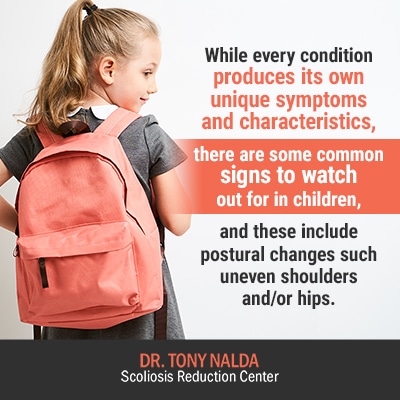
While every condition produces its own unique symptoms and characteristics, there are some common signs to watch out for in children, and these include postural changes such uneven shoulders and/or hips.
Even the most common of symptoms can be very subtle in mild conditions, which is why as beneficial as early detection is, it’s not always the easiest to accomplish. Not only are children far less likely to notice changes in their body (after all, they are growing and changing all the time), but it’s also very rare for children with scoliosis to experience pain related to their condition.
The above factors mean that, quite simply, it’s up to the parents and caregivers to look for and notice early indicators of scoliosis.
Also, when talking about adolescent idiopathic scoliosis, we are talking about adolescents and teenagers who are even less likely to share changes they might be noticing in their bodies. As parents of this age group are no longer bathing and dressing their children, the opportunities to notice the subtle changes that scoliosis can produce in children early on start to dwindle.
Early detection allows us to come up with a customized treatment plan with the highest chance of efficacy. As scoliosis is progressive, especially in patients who have not yet reached skeletal maturity, the sooner treatment is started, the better.
That being said, even with early detection, no one can guarantee positive treatment results; progression can still happen very quickly despite active treatment, but generally speaking, early detection can have a huge impact on treatment success.
When scoliosis is diagnosed in children prior to their first big growth spurt, there are far fewer limits to what we can do.
Understanding the Child’s Spine
The child’s spine is a complex and vital structure composed of bones, muscles, and ligaments, designed to provide support and flexibility. It allows for a wide range of movements and plays a crucial role in overall health and mobility. In children with scoliosis, however, the spine can develop abnormal curves, leading to various issues such as back pain, breathing difficulties, and decreased mobility. Understanding how scoliosis affects the child’s spine is essential for developing an effective treatment plan that addresses both the structural and functional aspects of the condition.
Types of Scoliosis in Children
There are several types of scoliosis that can affect children, each with its own characteristics and causes. Idiopathic scoliosis is the most common type, characterized by an abnormal curvature of the spine without any known cause. Congenital scoliosis is a rarer form that is present at birth, caused by a genetic mutation leading to vertebral malformations. Neuromuscular scoliosis, on the other hand, is associated with neurological or muscular disorders such as cerebral palsy or muscular dystrophy. Understanding the specific type of scoliosis is crucial for determining the most effective treatment approach.
Children with Scoliosis and Lifestyle
Staying physically active is important for anyone and everyone, but for people living with scoliosis, this is especially true.
When it comes to children with the condition, sports, exercise, and physical play are essential.
Juvenile patients who don’t engage regularly in physical activity run the risk of losing strength and mobility over time, and this can have a huge impact on how their body responds to treatment.
We need the spines, and surrounding muscles, of our young patients to stay as loose and flexible as possible so their scoliosis curves are more responsive to treatment.
Regular exercise is also linked to bone-density levels, which makes the body’s skeletal system stronger and healthier overall.
As we also know that girls are more likely to develop conditions of the skeletal system like osteoporosis, and are also at a higher risk of scoliosis progression, parents and caregivers should be especially encouraging of an active lifestyle for their female children.
Now, let’s move towards the two main scoliosis-treatment approaches that parents and caregivers have to choose between: traditional and functional.
Traditional Treatment Approach
For parents and caregivers of children recently diagnosed with scoliosis, knowing where to go from there can be overwhelming, especially as this choice has the potential to affect how that loved one experiences life with their condition.
While the traditional approach to scoliosis treatment is unlikely to recommend surgery for their juvenile patients, this approach does still funnel patients in that direction.
When scoliosis is diagnosed in a child, the traditional response is very cautious and based on passive observation. Most often, this would involve monitoring the condition to see its rate of progression and conducting examinations at regular intervals.
This approach, however, is risky as young patients can have a huge growth spurt in between those scheduled examinations, and then suddenly, that patient has progressed significantly to the point where they are in a whole different stage of severity.
Traditional bracing is sometimes used, such as the Boston brace, but this is used in an attempt to slow/stop progression of the spinal curve and doesn’t have correction as its end goal.
The traditional model of treatment for children involves a lot of biding time until a curvature progresses to the point where recommending surgery becomes justifiable.
Surgery is invasive and comes with a lot of risk factors, not to mention the fact that there is a lack of research on long-term effects.
Surgery and Pediatric Scoliosis
When it comes to children living with scoliosis, I feel it’s particularly important to help them avoid spinal-fusion surgery as their spines are still growing.
Juvenile early onset scoliosis that occurs between the ages of 3 and 10 carries a high likelihood of progression because this age group has so much growth yet to go through.
Even those who support surgery as a scoliosis treatment option rarely recommend it for individuals that young. Most view surgery for adolescents as an option once they have gone through those first major growth spurts.
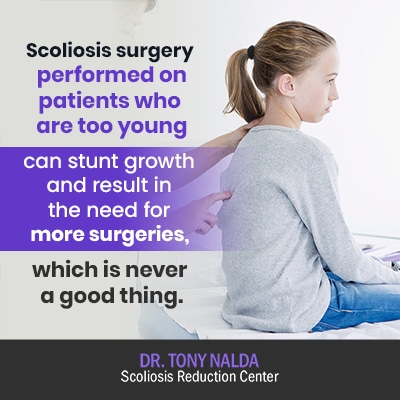
Scoliosis surgery performed on patients who are too young can stunt growth and result in the need for more surgeries, which is never a good thing.
Fortunately, there is another treatment approach available whose goal is to do everything possible to help these young patients avoid the operating table.
Functional Treatment Approach
A functional approach to scoliosis treatment is what we offer our patients here at the Center. It’s an integrative approach that’s characterized by action, instead of observation as in the traditional approach.
We combine multiple treatment disciplines so we can fully customize treatment plans to address the unique variables of each patient and their condition.
We want to help our young patients avoid needing scoliosis surgery later in life, so we want to start active treatment as close to the time of diagnosis as possible. We don’t feel the need to watch and wait to see how a condition progresses; it’s enough that we know it’s virtually guaranteed to do so.
We don’t waste valuable treatment time, we act quickly. That action involves combining scoliosis-specific chiropractic, therapy, corrective bracing, and rehabilitation to address different degrees of spinal curves based on the presented case.
Based on my experience, even for juvenile patients, this approach can be highly effective.
For children, treatment can be a challenge, and it can be a long road ahead for them and their families. The younger a patient is, the harder it can be because, of course, they won’t necessarily understand the ‘why’ and ‘how’ of what we are trying to accomplish.
For adolescent patients, we engage them in the treatment process, and this has huge benefits in terms of treatment efficacy and mental health. It’s good for these young patients to be able to gain some feelings of control they may have lost with their diagnosis.
With our chiropractic-centered approach, we have helped countless young patients avoid costly and invasive surgical intervention.
Now, let’s spend a little time discussing some of the main forms of scoliosis in children and how they develop
Scoliosis in Children: Infantile, Early-Onset Juvenile, and Adolescent
As mentioned, scoliosis can develop at any age.
When it comes to scoliosis in children, the umbrella term ‘pediatric scoliosis’ covers infants and juveniles as they have developed the condition before reaching adolescence.
As there is such a high prevalence of scoliosis in adolescents and they experience the condition so differently, we tend to focus on adolescent idiopathic scoliosis as its own category. This form of scoliosis affects the spine curves, which can undergo significant changes during growth spurts.
Scoliosis in Infants
The ‘infant’ category would include young patients between the ages of 0 and 3. This category can refer to cases of infantile idiopathic scoliosis or congenital scoliosis, which develops in utero.
In infantile idiopathic scoliosis, it’s etiology is unclear; in congenital scoliosis, there is an inability of the bones of the spine (vertebrae) to form properly.
In a healthy spine, the vertebrae are rectangular in shape, are stacked on top of one another, and are separated by intervertebral discs.
When one of those vertebrae are malformed and are triangular in shape instead, this can cause the spine to slip out of alignment and scoliosis to develop as a result.
While there is some data showing small curvatures in infants can sometimes resolve themselves, there is no way to know which ones will improve on their own and which ones will progress, which is why it can still be so important to act.
In these types of cases, treatment most often is a modified version of treatment we would implement for older children and teenagers, and this would likely combine scoliosis-specific therapy and corrective bracing.
Early-Onset Juvenile Scoliosis
As mentioned earlier, early-onset scoliosis affects children between the ages of 3 and 10.
As this age group is at a particularly high risk of progression, because they have so much growth yet to go through, without active treatment, these patients are very likely to experience progression throughout childhood and well into adulthood.
Individuals with the most growth ahead of them are at the highest risk of progression because, as we know, growth and development is the big trigger for curvature progression.
That is why seeking out active treatment is so important.
Adolescent Idiopathic Scoliosis
Adolescent idiopathic scoliosis is the condition’s most common form; it accounts for 80 percent of known diagnosed scoliosis cases and affects individuals between the ages of 10 and 18.
As the ‘idiopathic’ classification means there is no single known cause, we don’t fully understand how this form develops. The general consensus is that the condition is multifactorial, meaning caused by a combination of factors that can vary from person to person.
We know that girls are more commonly affected and are more likely to experience progression than boys, and we also know that treatment started early has better chances of success.
Our functional approach is about prevention and correction. We combine disciplines, apportioning them accordingly, based on how we see a patient’s spine responding to treatment.
We don’t want to just slow down progression; we want to impact the condition on a structural level by achieving a curvature reduction. By doing this, we are staying ahead of its progressive line and avoiding the hardships associated with further stages of progression.
5 Facts About Pediatric Scoliosis
Understanding scoliosis in young children requires a nuanced approach, particularly when considering the unique challenges and treatment options for juvenile early-onset scoliosis. Here are five essential facts that shed light on the complexities of managing this condition effectively, offering hope and direction for parents navigating this journey.
- Fact #1 – Early Diagnosis is Essential for the Best Outcomes: Early diagnosis of scoliosis in children under 10 is crucial for effective treatment and can potentially lead to better outcomes. Parents should be vigilant for signs like uneven shoulders or hips, as early detection allows for the development of effective treatment plans before the first major growth spurt. Despite the pain-free nature of childhood scoliosis, early detection is challenging yet imperative, as the condition tends to worsen over time.
- Fact #2 – Surgery Is Not an Option: For juvenile scoliosis, surgery is generally discouraged until the patient reaches their early teenage years, post-major growth spurt. Early surgical interventions can complicate growth and may necessitate multiple future surgeries. The consensus, even within the medical community, is to avoid surgery for juvenile scoliosis patients whenever possible, highlighting the complexities and potential drawbacks of surgical intervention at a young age.
- Fact #3 – Observation and Examination Are Standard Treatments: The traditional treatment approach for juvenile scoliosis is cautious, often involving a “watch and wait” strategy with regular examinations and sometimes the use of bracing to prevent progression. This approach is conservative, aiming to delay surgery until it is absolutely necessary, often leaving surgery as a last resort when curvatures progress significantly. The downsides of this approach are that the curve will progress the most in children, especially when they hit puberty and their bodies grow.
- Fact #4 – Children with Scoliosis Benefit from an Active Lifestyle: Physical activity is crucial for children with scoliosis, as it can prevent loss of mobility and strength, increase bone density, and support overall skeletal health. An active lifestyle is especially encouraged for female children, who are at a higher risk of developing conditions like osteoporosis. Parents are urged to promote sports and exercise among their children with scoliosis to enhance treatment effectiveness.
- Fact #5 – Chiropractic-Centered Scoliosis Treatment Can Be Effective for Juvenile Patients: Though not scientifically studied specifically in juvenile scoliosis patients, chiropractic-centered treatments have shown effectiveness in practice. This approach focuses on avoiding surgery and ensuring healthy development through a commitment from the patients, their families, and caregivers to maintain healthy habits and treatment routines. It represents a proactive and non-invasive option that may significantly benefit juvenile early-onset scoliosis patients.
Conclusion
When I see scoliosis in children, I take it very seriously and want to do everything right. This is because if we address childhood scoliosis properly, we have the potential to impact the rest of their life.
While most discussions of scoliosis in children tend to center around adolescents, as they most commonly develop the condition, younger children can develop it as well.
Infantile scoliosis affects children between the ages of 0 and 3, and this form can be idiopathic or congenital, meaning the condition either has no single known cause, or it developed in utero due to a vertebral malformation of the spine.
Juvenile scoliosis refers to children with scoliosis between the ages of 3 and 10, and this age group is at a high risk of progression because having not yet reached skeletal maturity, they are facing a lot of growth and development, known to trigger the condition’s progressive nature.
Adolescent idiopathic scoliosis is the condition’s most common form and affects individuals between the ages of 10 and 18. This age group is entering into, or going through, the stage of puberty, marked by rapid and unpredictable growth spurts.
Adolescents make up the majority of my patients, and together, we work closely to achieve a curvature reduction by addressing the structural nature of the condition.
These different forms of scoliosis in children appear at different ages and have different characteristics based on some of the factors we discussed: age, skeletal maturity, gender, and curvature pattern.
While there are never guarantees when it comes to scoliosis-treatment outcome, early detection has huge benefits in terms of treatment efficacy.
With scoliosis in children, the onus of noticing early signs of the condition falls mainly on the parents and caregivers, which is why it’s so important to be aware of the benefits of early detection and the early signs to watch out for.
Here at the Scoliosis Reduction Center®, I’ve treated patients of all ages, but when it comes to treating scoliosis in children, this is where I really like to make my mark as there is the potential to change the course of their entire lives moving forward.
